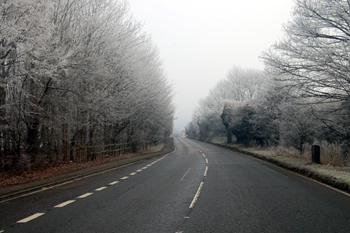![Iron Age arrow head found at Shirrell Spring [X325/146/125]](/CommunityHistories/Totternhoe/TotternhoeImages/Iron Age arrow head found at Shirrell Spring [X325.jpg)
Iron Age arrow head found at Shirrell Spring [X325/146/125]
The Iron Age lasted from around 700 BC until the Roman invasion of Britain in 43 AD and the subsequent gradual colonization of England and Wales. It was preceded by the Bronze Age. At this time casting and use of iron implements became widespread and at least by the latter part of the Iron Age the tribes referred to by Roman historians had settled territories. The tribe associated with what is now Bedfordshire were the Catuvellauni, one of the most powerful tribes, it is believed, in the southern part if Britain in the century or so before the Roman Conquest. The Bedfordshire Historic Environment Record is the basis for this article.
An area of chalk quarrying just north of Totternhoe, on a hillock known as Banbury Knap, exposed material dating from the Late Bronze Age onwards (HER 24). From the 1920s, finds of pottery and human bone were being retrieved, the pottery being of various dates from Late Bronze Age to medieval. In 1936-1938 an apparent settlement was recorded in the south west face of the quarry; four distinct areas were examined. These comprised two trackways, a pit containing pottery dating to the Late Bronze or Early Iron Age, and a hearth or occupation deposit overlying a ditch. Large amounts of carbonised grain were found in the pit, and a copper alloy pin in the possible hearth. Flints and animal bones were also recovered. Further finds of Early Iron Age pottery were made in 1968. Earthworks indicating lynchets thought to be of Iron Age date were recorded to the north east of the quarry in 1916 and the 1930s, and a cropmark or soil mark of a circular enclosure is shown on air photos in the vicinity of the finds.

Icknield Way looking towards Dunstable from the Well Head Road Junction January 2010
The line of a road or trackway believed to pre-date and partly underlie Watling Street was originally described as running from the Icknield Way, near to the Five Knolls (in Dunstable), to Maiden Bower (in Houghton Regis) (HER 276). Traces of stones marking its route were observed in Kensworth parish in the mid 19th century. Icknield Way itself runs across the eastern "neck" of Totternhoe parish from Eaton Bray before carrying on into Dunstable. It might date from quite early in prehistory and was probably at least early Iron Age in date.
A D-shaped enclosure found during quarrying. It had a single causewayed entrance approx 7.5m wide, protected by a heavy palisade just within the enclosure. The enclosing ditch was unfinished and appeared to have been partly backfilled soon after being dug, as pick marks were still visible in the sides and had not had time to weather away. The interior of the enclosure was disturbed, but a few post holes were identified, along with an ashy area interpreted as the remains of a hearth. A few fragments of pottery were found, and dated to the early Iron Age.
Another D-shaped enclosure [HER 1968] was found north of Middle End during quarrying. It had a single causewayed entrance approx 7.5 metres wide, protected by a heavy palisade just within the enclosure. The enclosing ditch was unfinished and appeared to have been partly backfilled soon after being dug, as pick marks were still visible in the sides and had not had time to weather away. The interior of the enclosure was disturbed, but a few post holes were identified, along with an ashy area interpreted as the remains of a hearth. A few fragments of pottery were found, and dated to the early Iron Age. Traces of Iron Age occupation were also found during quarrying nearby [HER 1970], including a decorated jar, a pit and a possible hearth. The pit contained a complete jar with fingernail impressions on the shoulder. The possible hearth consisted of a spread of ash containing animal bone and sherds of pottery similar to the fabric of the jar.
Finally, a field walking survey to the west of Shirrell Spring and north-east of Knolls View [HER 16275] was centred on the site of a known Iron Age and Roman site. The finds recovered from the site included a large amount of Romano-British pottery and tile with lesser amounts of Iron Age and Medieval pottery. The scatter took on a linear form and the ceramic finds were associated with small scatters of stones and slag, which suggests that the site may have had some form of industrial activity occurring on it. The linear scatter itself may suggest the dumping of material into a ditch. Between 1913 and 1920 other Iron Age artefacts were found, including the arrow head shown at the head of this page [X325/146/125].